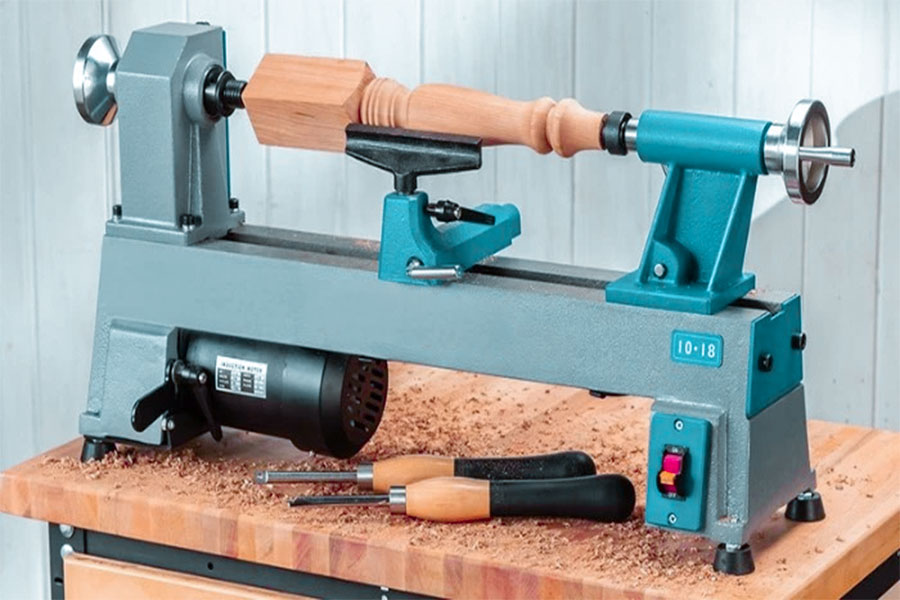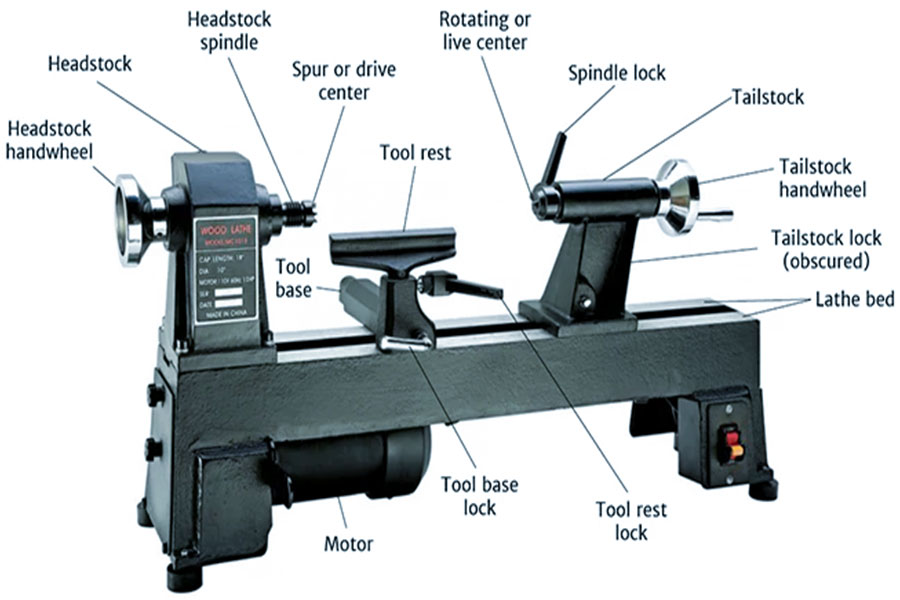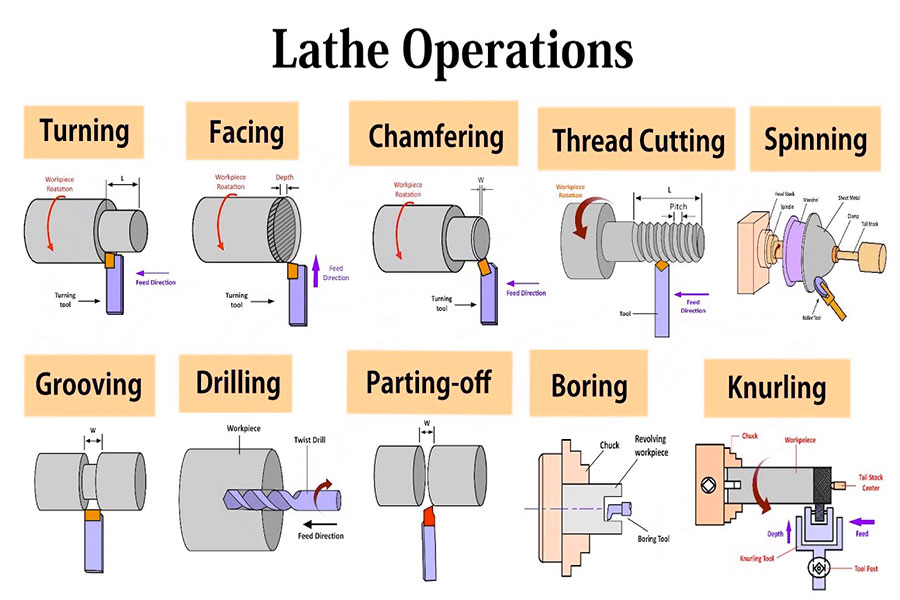From rough wood to silken contours, the secret lies in this machine
Did you ever marvel at those gleaming wooden bowls, handsome table legs or elegant pens? Did you ever quiz yourself as to how alinear angular length of wood can be enchanted to transform into these circular lovely pieces full of vitality? The magic lies not in magic, but lies insidiously hidden in an aged and potent tool -thewood lathe.
It is this seemingly simple process that gives wood the essence of rotation.Imagine: a rough log wedged closely between the tops at either end of the lathe. When the motor is switched on, it starts to rotate high speed, and the wood shavings fly like gold shavings. Meanwhile, the skilled craftsman holds in his hand a keen turning tool and approaches the whirling wood calmly and accurately. Where the blade passes over, the wood seems to be tamed and peeled away layer by layer and shaped. Every slow feed and angle change of the turning tool forms silky contours, elegant grooves or precise diameters on the whirling wood surface.
From thin table legs from the circular bowl to the exquisite pen holder, the lathe is a quiet sculptor, marrying the craftsman's imagination with the natural wood grain. It is both the physical embodiment of power and a stately dancing companion, allowing static wood to be rebornturning.The machine that interprets the ordinary to the enchanted is the core of the solution - the wood lathe. How does it perform this magic on your fingertips? Let's discover that together.
Core Anser Summary
It is a wood lathe.Essentially, it spins wood at highspeedso you can cut and shape itusinga fixed tool.
| Core answer | What is this amazing machine? | It is a wood lathe. Its core principle is: the wood is rotated at high speed, and the user holds a fixed tool to cut and shape it. |
| 1 | What exactly is a wood lathe? | In-depth analysis of the basic definition, core working principle and unique position of wood lathe in the field of woodworking. |
| 2 | What are the key parts of it? | Detailed introduction to the functions and roles of core components such as lathe bed, spindle/headstock, tailstock, tool holder (bracket), motor, etc. |
| 3 | What supporting tools are needed to use it? | List and explain the necessary turning tools (roughturning tools, fine turning tools, scrapers, cutters, etc.), chucks, centers, measuring tools, etc. |
| 4 | What can it do? (Application range) | Show the wide range of uses of wood lathes: from wood-turning works such as bowls, pens, vases to furniture parts such as table legs and columns. |
| 5 | Seeking industrial-grade precision? (Advanced solution) | Introduce howCNC turning worksto achieve automated, high-precision, and mass production of complex shapes. |
This tutorial will take you through the basics of a wood lathe - what it is, what it's constructed from, what tools are required, what it can accomplish, and how CNC turning works if you're interested in bringing this art to industrial level accuracy.
Why Trust Our Analysis? From Manual Turning To CNC Turning, We Understand
Hi, I'm Gloria, LS engineer.My close acquaintance with rotary machining began in my dad's woodshop. There, I became fascinated with manual turning: the feel of the tool tip between my fingers, the spinning sawdust like threads of gold, and the coarse wood blank gradually took on an elegant shape in my hands.The pleasure of shaping by hand and the awe of the miracle of "rotational forming" are in my blood.
I operateaprecision CNC latheto turn metal components today. Folks think this is a significant departure from the comfort of handwork, but I think otherwise.
It was that flying sawdust experience that gave me a different perspective about learning CNC:
I feel "feel":Manual turning taught me the gigantic difference that can be achieved with tiny changes. This makes me especially sensitive when defining theCNC cuttingparameters (speed, feed, depth of cut), seeking a condition that makes the material "sing smoothly" and not vibrate or become rough.
I receive "shaping":From the computer-aided design model, I am able to envision readily "anticipating" the way that the tool path will remove the material layer by layer, similar to the turning tool wandering around the wood blank. This optimizes my programming and fixture plan, so complicated designs may be attained efficiently and accurately with control of every step.
I know materials:Wood is temperamental, so too is metal. My hands-on experience has shown me how to "hear" materials. Translated inCNC machining, this means having a keen appreciation of material attributes, leading me to properly choose tools, coolants and approaches.
Why LS?Because our knowledge is not only a product of advanced tools, but also thisbloodline crossing manual craftsmanship to automated precision manufacture. We truly share your full considerations of accuracy, efficiency and price, and we are also aware of the challenges of transitioning frommanual to CNC. We provide competitiveCNC turning servicesand give deep insights from passion.
Because we value the power of turning and the art and science of shaping materials - this regard that starts with wood shavings has been the character of our metal precision processing time and time again.In LS, you have a partner that really values "rotational forming".
The Anatomy Of A Woodworking Lathe: An Introduction To The Machine's Interior
Before you turn it on, let's get to know its key components.
A quick rundown of a woodworking lathe's key components
| Component name | Core function | Key features |
|---|---|---|
| Bed | The backbone and base platform of the machine | A solid cast iron structure that provides stability and carries all other components. |
| Spindle box | The power source and the core of rotation | The built-in motor drives the spindle, directly clamping and driving the wood to rotate at high speed. |
| Tailstock | A movable auxiliary support point | Can slide and lock along the bed, with the top supporting the other end of the wood for support. |
| Tool holder | A stable operating platform for the turning tool | Adjustable height and position, providing a solid fulcrum for hand-held turning tools to ensure safety and precision. |
| Power system | Energy and speed control center | The motor provides power, and the pulley set or electronic speed regulator controls the spindle speed range. |
- Bed:It's like the "backbone" and "foundation" of the machine. It's made of very hardcast iron, which holds all the other parts in place sturdy and keeps the lathe from vibrating when in use.
- Spindle box:This is the "heart" and "spindle" of the lathe. It holds the motor inside, which causes the front chuck (or center) to turn wildly, and the wood will whir along with it.
- Tailstock:It is identical to a "movable bracket". It is installed at the other end of the bed and will move in and out and clamp. It extends a pin to keep the other end of the wood so the wood will not spin crooked or shoot out.
- Tool holder:Your "safety handrail" when supporting the knife to work. Adjustable iron rod in height and distance. Your turning tool is placed on it to work, so the knife does not shake and the wood cuts safely and precisely.
- Power system:The "strength" and "shift lever" of the lathe. The motor provides the power, and speed is adjusted by shifting the belt or using buttons, allowing you to turn the wood fast or slow as you want.
The wood lathe is in the same category as a machine that has interworking components: the solid foundation is the skeletal system, the spindle box is the motor heart pumping the wood into spin, the tailstock is the adjustable auxiliary support, the tool holder is the master platform for safety and precise control, and the power system supplies power for all of these and controls the speed. Knowing these "internal organs" is the key to safe and effective usage of a lathe.

Two Significant Turning Schools: Spindle Turning And Face Turning (Bowl Type)
| Features | Spindle Turning | Faceplate Turning | Notes |
|---|---|---|---|
| Core Difference | The wood rotates longitudinally, and the grain is parallel to the axis of rotation. | The wood end face rotates, and the grain is perpendicular to the axis of rotation. | This is the most fundamental difference between the two, which determines the operation method and applicable objects. |
| Wood Fixing Method | Fixed between the lathe spindle box (driving end) and the tailstock (following end). | Only fixed on the panel or chuck at one end of the spindle box.The tailstock usually does not participate in supporting the wood itself. | Spindle turning is "two-point support", and face turning is "single-point cantilever support". |
| Wood Grain | Direction The wood grain direction is parallel to the lathe bed (rotation axis). | The wood grain direction is perpendicular to the lathe bed (rotation axis). | The grain direction directly affects the cutting method of the tool during turning and the strength performance of the wood. |
| Typical products | Objects that are long, cylindrical or have symmetrical contours: - Table legs, chair legs, railings - Baseball bats, sticks - Pens, rolling pins - Candlesticks, spindles |
Objects that are flat, disc-shaped or hollow: - Bowls, plates, dishes - Platters, trays - Box lids/bottoms - Vase (body) - Ashtrays |
Spindle-turned products are usually symmetrical along an axis; face-turned products are usually rotationally symmetrical about an axis and involve end machining to create a hollow or concave surface. |
| Wood size limitations | Length is limited by lathe bed length (spindle to tailstock distance). Diameter is relatively small. | Diameter is limited by lathe swing diameter (space above tool rest). Length (depth) is limited by cantilever stability and tool accessibility. | Spindle turning excels at long pieces; face turning excels at large diameter but relatively short pieces. |
| Operating characteristics | Turning is mainly performed on the cylindrical surface of the wood. Tool movement direction is usually parallel to the axis or along the contour. | Turning is mainly performed on the end face of the wood. The tool movement direction is usually perpendicular to the axis (radial) or along the end face contour. It is often necessary to hollow out the interior. | Scrapers and bevel knives are commonly used for spindle turning; round nose scrapers, bowl scrapers, bevel knives (for trimming and hollowing) are commonly used for face turning. |
| Speed | Usually a higher speed can be used. | Relatively low speeds are usually used, especially for preliminary processing, large diameter or irregular wood to ensure safety and reduce vibration. | Face turning is more cautious about speed requirements due to single-point fixation and often involving unbalanced blanks. |
| Safety considerations | The wood is firmly fixed and relatively difficult to fly out.Standard protection is still required. | Wood fixing is crucial. When the blank is irregular in shape (especially in the preliminary processing stage), the risk of unbalanced center of gravity is higher, special attention should be paid to firm fixation and balance, and low speed is strongly recommended. | The operating safety risk of face turning is generally considered to be slightly higher than that of spindle turning, especially for beginners. |
- Spindle turning:Like turning a column, the wood is fixed at both ends, and the grain is along the length direction (parallel to the axis of rotation), and the objects made are long and straight (or symmetrical contours), such as table legs and pens.
- Face turning:Like turning a wheel or a plate, the wood is only fixed at the center point, and the grain is facing you horizontally (perpendicular to the axis of rotation). The main processing end faces are used to make flat or concave objects such as bowls and plates.
Understanding the fundamental differences between these two schools (fixing methods and wood grain direction) is the basis for mastering woodworking turning, which directly determines the applicable project types, tools used, operating techniques and safety precautions.

Don’t Do A Job Without A Diamond Drill: Your First Set Of Essential Turning Tools
The lathe gives wood a life of rotation, and theturning toolis the “diamond drill” that you use to shape this life. A set of basic turning tools is the key to starting your turning journey:
- Roughing Gouge:Your “pioneer”. Its wide and strong blade is designed to remove excess wood at high speed. It can quickly turn square blanks into cylinders efficiently and safely, laying the foundation for subsequent finishing.
- Spindle Gouge:The slender and elegant “Master of Curves”. With a shallow spoon-shaped blade, it excels at turning smooth grooves (such as beads, concave circles), convex shoulders (such as rings) and fine curves on column-type workpieces (such as chair legs and pen barrels), and is the main force in shaping details.
- Bowl Gouge:The "workhorse" of bowl and plate making. Stronger and heavier than the spindle gouge, usually featuring deeper grooves and reinforced handles. Its unique shape (especially the side grind) enables it to aggressively and accurately cut on the inside and outside walls of container workpieces such as bowls and plates and to cope with end grain's challenges.
- Parting Tool:A precise "cutter." The narrow, straight blade is a sheet-like entity. Mostly used to cut cleanly into the wood to produce a shallow groove (for measurement of depth or for ornamentation), or to cleanly separate the finished workpiece from the waste end.
Scraper: Asurface-finishing"sanding aid." Usually a rectangular or circular flat blade. It doesn't cut high power, but scrapes extremely thin shavings of wood to finish the surface from turning, erase car marks, flatten planes or slightly alter the shape to achieve a smoother appearance. - Skew Chisel:A tough "double-edged sword." Flat diamond-section blade used at some angle (bevel). Toughest to master, but superior performance. Managing its angle of edge with finesse can produce a mirror finish (planing effect), accurately turn cones and planes, and cut clean ornamental V-cut grooves and fine thickenings.
Thesesix turning toolsare each given a role and cover the basic operations of woodturning. Choosing them is like having a handy "diamond drill" with which to make your "porcelain work" on the lathe dazzling. They are the lathe's soul mates, helping you shape turning wood into lovely works of art and practical items.

Case Brief: Helping Designers Scale Up the Creative Mass Production of Wooden Pen Holders
I'd like to point out one of our recent successful projects showing how we support innovative designs with efficient and accurate mass production.
Client Needs:A designer designed a wooden pen holder of cylindrical shape with high-tech grooves for his design studio. His handmade prototype was very adorable, but when he tried to mass-produce it in batches (50 units), he failed miserably due to the following serious problems: since it was done manually (using a woodworking lathe and chisel), it was difficult to ensure consistency of the groove depth and distance of each pen holder, and individual production was too time-consuming to meet the order demand and time cost constraints.
LS Solution:The designer approached LS in quest of an automated production solution. Our professionals jumped into action right away:
- Design Conversion:We converted the designer's hand drawings accurate digitalCAD modelsto ensure that the essence of their designs was duplicated completely and in a standardized way.
- Process Upgrade:We recommended and appliedCNC turning technologyas the core solution. We converted the CAD model to machine code by means of expert programming.
- Automated manufacturing:Ouronline CNC turning serviceplatform precisely programs the CNC lathe to turn automatically and perfectly reproduce every groove in the design.
Achievements:
- Accuracy and consistency:The 50 pen holders successfully produced attained extremely high dimensional consistency, and depth and spacing of every groove were precisely reproduced, far above the manual level.
- Improved quality:Surface finish of the product is much better than in the manual mock-up with a greater process level achieved.
Leap in efficiency:The entire production process was shortened to just a few days, meeting the customer's delivery expectation. - Cost reduction:The total cost of manufacture (especially the cost of the designer's time) is much lower than the customer's do-it-yourself equivalent.
Case value:This case is a classical example of LS's business - we are good at transforming designers' own hand-made individual creative prototypes by professional engineering conversion (CAD) and advanced automated manufacturing technology (CNC) to achieve efficient, high-quality, low-cost mass production, seamlessly bridging creativity and the market. This clearly demonstrates the tremendousadvantages of CNC machiningin overcoming the agony of repetitive manufacturing of complicated geometric shapes.
Safety First! The Golden Rule Of Woodturning
The combination of high-speed spinning wood and sharp turning tools is a powerful tool for creating works of art, but it also hides risks that cannot be ignored. Safety must be put first in every operation. Please be sure to strictly follow the core rules below, which is the basis for your personal safety.
- Safety equipment:Always put on a mask or goggles! Chips and splinters of wood will fly.
- Inspect the wood:Ensure that there are no cracks, big knots or nails in the wood.
- Fix securely:Turn the wood by hand before switching on the machine to ensure it turns easily and is securely fixed.
- Position of tool holder:The tool holder should be positioned as close as possible to the wood, but not touching the wood.
- Two-handed use:Always keep the turning tool between both hands.
- Speed control:Start slowly and gradually increase the speed after the wood is round.
- Attire:Steer clear of loose clothes, gloves, and pin up long hair.
Safety is not a trivial matter, and expertise derives from conventions. Always remember and practice these golden rules, being the most reasonable approach to learn about yourself, your dear ones, and this passion. Let every turn be a pleasant experience of safety and fantasy
"Can I Turn Wood Without A Lathe?" - Alternatives And Limitations
When asked if it is possible to turn round wood objects with anything other than aprofessional lathe, the answer is always "theoretically yes, but.", and one can't ignore its limitation and risks.
Discussion of DIY alternatives
- Electric drill + tool solution:This is the closest approximation of "turning". The electric drill is attached to the vise, and a small piece of wood is clamped in the electric drill chuck as a "spindle" to be turned. The chisel or scraper is gripped by the user, and it cuts on the rotating wood to simulate the operation of a simple lathe.
- Other shape tools:i.e., band saws, belt sanders, files or carving knives, etc., can be used to "shape" wood to round, or near round, shape. But this is actually material removing shaping, not the use of rotation to remove material progressively from a continuous, concentric turning.
Core limitation analysis
- Extremely low accuracy:Other methods (particularly electric drill solutions) can scarcely ensure the actual roundness and concentricity of the workpiece. Vibrations of the drill, hand-held tool instability, and small fixture displacement will generate distorted and unsymmetrical results.
- Very dangerous:Unstable makeshift equipment (a jig drill that wobbles) or small rotating handheld workpieces are very susceptible to loss of control. Wood rotating at high rates may shatter and fly around, and the handheld equipment can be easily dropped from the hand due to jamming of the tool or vibration risk to the operator. Stability is the biggest weakness.
- Strongly limited in use:These methods can only handle very small and very simple shapes (e.g., very small circular bars and simple spheres). High-precision cylindrical turning, taper cutting, slotting, turning complex curves, and internal and external circle treatment of large parts are completely impossible, and the productivity is also extremely poor.
Although emergency or low-technology solutions do arise, they are full of compromises and huge risks, and the outcome is far less than professional equipment. For any real woodworking project that wants precision, safety and efficiency, or wants to build things beyond the most primitive forms, a solidly engineered woodworking lathe is an absolutely essential foundation tool. The substitutes are good enough for an extremely few extremely specific and low-demand conditions.

FAQ - Last Questions on Wood Turning
1.What is the difference between a metal lathe and a wood lathe?
The major differences between wood lathes and metal lathes are structure, speed, and operation: structureally, metal lathes are heavier and stronger to sustain monstrous cutting forces; speed, wood lathes typically have higher speeds as they work on wood, which needs higher speeds; operation, the turning tool of a wood lathe is held by hand to provide flexibility, while that of a metal lathe is mounted hard to the tool holder to provide stability. They should put them together separately because the lathe design differences may cause equipment damage or accidents, for instance, the wood lathe cannot handle metal hardness.
2.What size lathe do I need to buy?
Choosing the lathe size depends on the type of project: if you will only make very small items like pens, a desktop mini lathe is adequate, it is small and cheap, best for beginners; but if you are going to make large items like bowls or table legs, you need a heavier and longer floor-standing lathe, which provides you with stability and ample working space. Floor-mounted lathes are a huge investment. A careful determination of the actual needs, budget and space is recommended in order not to purchase machinery too large or too small for effective and safe utilization.
Is wood turning difficult to learn?
Wood turninghas a low entry threshold. You can quickly learn to turn out basic shapes such as decent cylinders, which is suitable for novices to quickly get started; but to master it, especially to master advanced tools such as bevel knives, it takes a lot of practice and patience, because the skills involve hand-eye coordination and tool control. It is recommended to start with simple projects and gradually challenge complex works. Mistakes are part of learning. You will have fun and a sense of accomplishment if you stick to it.
Summary
The charm of wood turning comes from giving wood the power of rotation to create infinite possibilities. The traditional woodworking lathe is the key to opening the door to this art. It allows you to manipulate the tool with your own hands, feel the creativity of sawdust flying, and inject your imagination directly into the rotating log to create a unique handmade work of art. When the creativity needs to be scaled, complicated, or reach strict industrial precision, CNC turning represents the modern evolution of this ancient craft. It accurately transforms the design into reality with unparalleled efficiency and consistency.
Whether you have an inspirational sketch of a handmade wooden bowl in your mind, or need to mass-produce thousands of complex CNC turned parts with precise tolerances, LS understands the essence of it. We are proficient in the "power of rotation" from traditional rotation to digital control. Upload your design drawings to the LS platform now, and you can get an instant and transparentCNC turning quotein just a few simple steps. Let us use this deep understanding of "rotation" to work together to turn your wood turning ideas - whether simple handmade or modern precision - into a reality that is within reach with efficiency and accuracy! Start your creative journey!
📞Tel: +86 185 6675 9667
📧Email: info@longshengmfg.com
🌐Website:https://lsrpf.com/
Disclaimer
The contents of this page are for informational purposes only.LS seriesThere are no representations or warranties, express or implied, as to the accuracy, completeness or validity of the information. It should not be inferred that a third-party supplier or manufacturer will provide performance parameters, geometric tolerances, specific design characteristics, material quality and type or workmanship through the LS network. It's the buyer's responsibilityRequire parts quotationIdentify specific requirements for these sections.Please contact us for more information.
LS Team
LS is an industry-leading companyFocus on custom manufacturing solutions. We have over 20 years of experience with over 5,000 customers, and we focus on high precisionCNC machining,Sheet metal manufacturing,3D printing,Injection molding,Metal stamping,and other one-stop manufacturing services.
Our factory is equipped with over 100 state-of-the-art 5-axis machining centers, ISO 9001:2015 certified. We provide fast, efficient and high-quality manufacturing solutions to customers in more than 150 countries around the world. Whether it is small volume production or large-scale customization, we can meet your needs with the fastest delivery within 24 hours. chooseLS technologyThis means selection efficiency, quality and professionalism.
To learn more, visit our website:www.lsrpf.com








